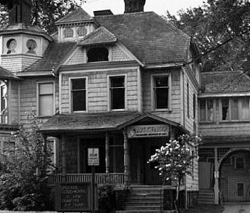

American Legion Post 36 Officers, 1919
1- R. Wheeler Rickman, Finance Officer 2- Carl D. Proctor, Vice-Cmdr. 3- James M. Wilson, Cmdr. 4- Charles B. Bietry, Historian, 5- J. W. Kramb, Adjutant 6- Grant Church, Chaplain, 7- Wm. Waite, Sgt. at Arms.Kalamazoo Veterans
Were Quick to Found
American Legion Post
in 1919.
Kalamazoo Gazette, 1969 By Llyle Rapp, Past Post Commander, 1925 It didn’t take the Kalamazoo veterans who had already returned from service in WWI long to formalize plans for an American Legion post here after receiving notice that such an organization for United States veterans had been organized at the caucus in Paris, France March 15 – 17, 1919. The first informal meeting of local veterans to organize a post was held Friday night, March 21, 1919 in the Armory. Between 28 and 30 Kalamazoo veterans attended. Their first meeting was devoted entirely to a review and explanation of actions taken at the Paris caucus, especially a study of the principles and objectives approved by the Americans in Paris. So much interest was evidenced at the first local meeting that a second meeting was scheduled the next week on Friday, March 28, when all veterans present were asked to invite other veterans to attend. Ralph Henshaw and Milton Courtney were named co-chairmen. Several more organizational meetings were held during April, and one action taken by the local veterans was to postpone the official organization of the post until “Kalamazoo’s own” Company C., 126th Infantry, 2nd division had returned home. The arrival date was May 20.
With the Co. C boys back, the organization
process quickened and by mid-August the
Kalamazoo post, which had been
unanimously named in honor of the late
Col. Joseph B. Westnedge, commander of
the 126th Infantry and who died of
pneumonia in France shortly after the Nov.
11 signing of the Armistice, elected
officers and applied for a charter. The
charter was granted in September.
The only difficulty encountered in
recruiting charter members in the post- a
minor one- was the belief on the part of
some veterans that a clouded purpose of
the American Legion might be to obtain
signatures of veterans who might later be
obligated by the United States government
to return to military service. This
misconception was successfully overcome
within a few weeks.
Capt. James M. Wilson of Company C. was
elected the first commander. Among other
officers were Wilbur W. Kramb; Milton
Courtney; Alfred Eagelton; Lt. W. Douglas
Hall, Company C., who attended the Paris
caucus; Ralph Henshaw; Nell Priester;
Truman Strong; and Llyle Rapp.
After completion of the organization in
August, the new Post rented the former
Knights of Pythias hall on W. Michigan,
where it met for a year. The post then
moved to quarters over the former Home
Savings Bank on W. Michigan, until it
outgrew those quarters. In the meantime,
even before the Armistice, patriotic
citizens of Kalamazoo had drafted a plan to
erect a veterans’ memorial building on the
vacant lot on E. South St. and had
obtained pledges of several thousand
dollars, but the plan did not materialize.
Somewhat frustrated, and without a post
home, the Legionnaires assembled forces
late one night in 1924 and with shovels,
picks and carpenter’s tools, swarmed in
the vacant lot on E. South (proposed site
of the memorial building) and built a post
“home” which they dubbed “the Legion
Dugout”. Half under and half above
ground, the dugout served as a meeting
place for several weeks.
The Legionnaires in the meantime
inaugurated a campaign to collect on
pledges previously made toward the
memorial under direction of past
commander Wilson and the post home
committee. The campaign yielded
sufficient funds and the post purchased
the Charles Peck home at 421 W. South
St. with an additional generous
contribution from the Peck family. The post
moved into the home in 1925. The only
later move was a few years after World
War II when the former Jewish synagogue
at 433 E. South was purchased and still
serves as the post home. *
Kalamazoo has been the home of six
American Legion posts since World War I.
Most active now are Joseph B. Westnedge
Post 36 and Kalamazoo Post 332. Outpost
Post, organized during World War II, still
has its charter. Posts which have become
inactive were the Hanes-Molloy Post,
Phillips Carr Post, and Dr. Caroline Bartlett
Carr Post for women veterans.

















